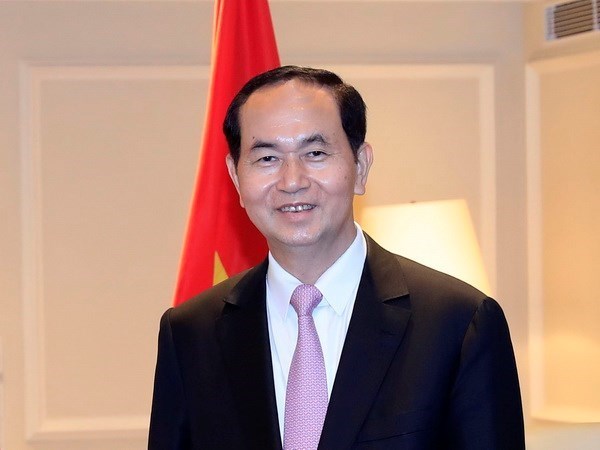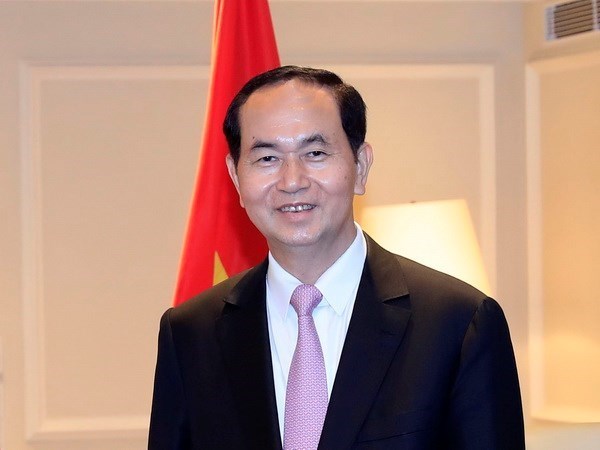



President Tran
Dai Quang (Source: VNA)
Vietnam and Japan set up their diplomatic ties in September 1973.
Over the past years, the two countries have become important partners of each
other in many fields. Since Vietnam and Japan lift their relationship to
Extensive Strategic Partnership for Peace and Prosperity in Asia in March 2014,
the two sides have enjoyed strong, comprehensive and practical progress in
bilateral ties.
Japan was the first G7 country to welcome the General Secretary of the
Communist Party of Vietnam (CPV) in 1995, and also the first G7 member to set
up a strategic partnership with Vietnam in 2009, recognise Vietnam’s market
economy in 2011, and invite Vietnam to join the expanded G7 Summit in May 2016.
Bilateral partnership is now at its best time in history since the establishment
of diplomatic relationship. Senior leaders of the two sides have maintained
regular visits and meetings at international and regional forums. The Prime
Minister of Japan visited Vietnam 10 times, while the Speaker of the Japanese
House of Representatives made two visits to Vietnam.
Speaker of the House of Councillors of Japan Yamazaki visited Vietnam in
December 2015, while Prince Akishino paid an official visit to Vietnam in June
1999 and a private visit in August 2012. The Crown Prince visited Vietnam in
2009, while the Japanese Emperor and Empress visited Vietnam in 2017.
Meanwhile, the General Secretary of the CPV made four visits to Japan, while
the State President made two visits, the Prime Minister made six official
visits and nine working visits, and the National Assembly leader also made two
official visits to Japan.
The two sides have implemented important cooperation mechanisms, including the
Vietnam-Japan Cooperation Committee co-chaired by the two Foreign Ministers
(which has met 9 times since 2007), the bilateral strategic dialogue on
diplomacy-security-defence at Deputy Foreign Ministerial level (six meetings
since 2010), the Vietnam-Japan defence policy dialogue at deputy ministerial
level (five meetings since November 2012), and security dialogue at deputy
ministerial level (five meetings since November 2013), the joint committee on
trade, energy and agriculture cooperation (two meetings since 2014), and the
agricultural dialogue at ministerial level (three meetings since 2014).
The two sides have cooperated closely and effectively at multilateral forums
such as the United Nations, the Association of Southeast Asian Nations (ASEAN),
the Asia-Pacific Economic Cooperation Forum (APEC), and the Asia-Europe Meeting
(ASEM).
Japan has been the leading economic partner of Vietnam. The two sides have
granted each other the most favoured nation tariff since 1999. In 2017, two-way
trade revenue reached 33.4 billion USD, a rise of 16.8 percent over 2016. In
the first three months of 2018, the figure reached 8.7 billion USD, up 15.7
percent over the same period last year.
In 2017, Japanese investment in Vietnam hit a record high at 9.11 billion USD,
making it the biggest investor in Vietnam. As of March 2018, Japan has run
3,693 FDI projects in Vietnam worth 49.839 billion USD, ranking second in 116
countries and territories investing in Vietnam.
From the beginning of 2018 to March 20, Japanese investors poured 592.67
million USD into 96 new projects, 42 underway projects and capital contribution
or share purchase deals, turning Japan into the fourth largest foreign investor
of Vietnam.
So far, Japan has been the biggest ODA provider of Vietnam, focusing on
infrastructure building, competitiveness enhancement, high-quality human
resource training and climate change, greatly contributing to Vietnam’s
socio-economic development.
From 1992 to the end of the 2016 fiscal year (March 2017), Japan committed
about 30.5 billion USD of ODA for Vietnam. Last year, the two sides signed
deals for five projects funded by Japanese ODA loans, three ODA borrowing
agreements, and four projects using Japanese non-refundable aid. Japan has also
pledged to provide ODA to two new projects in the 2017 fiscal year.
Bilateral partnership in security-defence, agriculture, education-training, and
labour have also been fruitful. People-to-people exchange, cultural and tourism
affiliation have seen strong development.
At the same time, bilateral agricultural partnership achieved a breakthrough in
September 2015 with the signing of an agreement on middle and long-term joint
vision in agricultural cooperation on the occasion of the Japan visit of
General Secretary of the CPV Nguyen Phu Trong.
Cooperation in climate change response has also been expanded, with Japan
continuously providing ODA to Vietnam in the field.
In labour cooperation, since 1992, Japan has received a large number of
Vietnamese apprentices. The two sides have signed a memorandum of understanding
on Japan’s receiving Vietnamese nurses and orderlies and another on cooperation
in apprenticeship.
The Vietnam-Japan education-training partnership has expanded in many forms.
Japan has been one of the biggest providers of non-refundable aid to Vietnam’s
education and training sector. The two sides signed many cooperation deals in
the field, including an agreement on the training of 1,000 doctoral degree
holders for Vietnam to 2020 and the teaching of Japanese in Vietnam.
So far, about 75,000 Vietnamese students are studying in Japan. The Japanese
side is also cooperating with Vietnam in upgrading four Vietnamese universities
and in establishing the Vietnam-Japan University to train high-quality human
resource for Vietnam in science-technology, management and service.
In 2017, Japan ranked third in the number of tourists to Vietnam. In the first
three months of this year, the number of Japanese tourists to Vietnam reached
215,427, up 6.9 percent over 2017, ranking third after China and the Republic
of Korea.
Japan opened its General Consulate in Ho Chi Minh City, while Vietnam also
launched its General Consulate in Osaka and Fukuoka. In June 2010, Vietnam
appointed two Honorary Consuls General in Nagoya city of Aichi Prefecture and
Kushiro city in Hokkaido Prefecture of Japan.
Since July 1, 2014, all Japanese citizens enjoy short-term visa exemption in
Vietnam.
Since May 1, 2005, diplomatic and official passport holders of Vietnam and
Japan have been entitled to visa exemption for 90 days. Japan has also loosened
its visa policy for Vietnamese citizens.
The State visit of President Tran Dai Quang and his spouse aims to affirm
Vietnam’s consistent external policy of independence, self-reliance,
multilateralisation and diversification in international relations, as well as
the importance that the country attaches to strengthening the extensive
strategic partnership with Japan.
The visit also aims to bolster the close relationship and political trust
between senior leaders of Vietnam and Japan, contributing to strengthening the
bilateral extensive strategic partnership.
Source: VNA